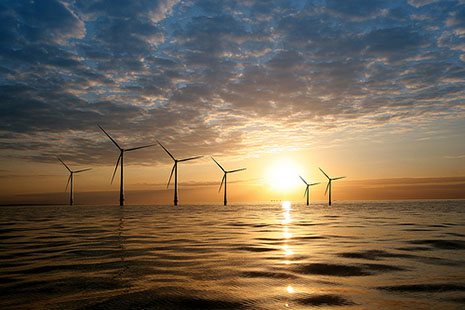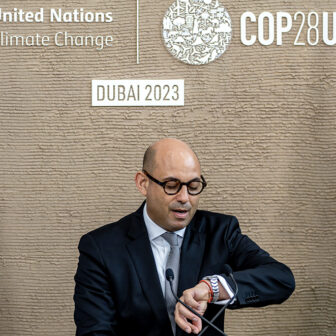AS NEGOTIATORS meet in the Chinese port of Tianjin for the final preparatory talks before next month’s UN Climate Change Conference in Mexico – the follow-up to last year’s Copenhagen Summit – a remarkable debate is brewing in Europe. Governments and businesses are posing a radical question: should the European Union simply ignore the negotiations and move towards a low-carbon economy regardless?
The very idea that Europe might unilaterally push ahead of other countries in reducing its greenhouse emissions represents a remarkable reversal of the dominant view, not only in Europe but also throughout the developed world. It’s long been assumed that action on climate change had to proceed in a coordinated fashion. Curbing emissions was economically expensive, it was argued, hence countries or regions could not act unilaterally: to do so would simply drive industry overseas to less punitive markets. Only a new climate change treaty could secure the necessary action in individual countries. When failure at Copenhagen made it clear that such a treaty was not going to be agreed on any time soon, the dominant view appeared settled: radical emissions reduction plans would remain on hold. In Europe’s case, this meant that the European Union would retain its agreed target to reduce emissions by 20 per cent (on 1990 levels) by 2020, but no more.
Yet just a few months later Europe is debating whether or not the European Union should increase its 2020 emissions cuts to 30 per cent. A joint statement by the British, French and German environment ministers in favour of 30 per cent set off the debate; Denmark, Ireland and the European Union’s climate commissioner have all now backed the call. Even more remarkably, a group of leading European businesses have publicly stated their support.
How is this possible, when the European Union couldn’t agree on the 30 per cent figure during the negotiations in Copenhagen, at a point where it might actually have helped move other countries towards a deal? Three factors have shifted the argument over recent months.
First, European governments have had to acknowledge that the recession has made a 30 per cent cut by 2020 much less expensive than it once appeared. A drastic decline in economic output pushed Europe’s 2009 emissions 7 per cent down on 2008, leaving the European Union already more than 17 per cent below its 1990 level. This makes achieving its targeted 20 per cent cut by 2020 much easier and cheaper than originally anticipated. Indeed, the European Commission calculates that reducing by 30 per cent instead would now cost the European economy only a little more than the 20 per cent target was projected to cost when it was first agreed.
While the effect of the recession in cutting the European Union’s emissions has been good for the planet, it has been particularly damaging to Europe’s flagship climate policy, its emissions trading scheme, or ETS. The scheme works by capping the total emissions from power producers and industry, and then allowing firms to trade pollution allowances, thereby putting a price on carbon and giving an incentive to efficient reduction. But the recession has created a huge surplus of permits in the system, as firms find that with much lower output they do not now need their full allocation. Permits not used in the present ETS period can be carried over into the next period after 2012, so the surplus threatens to undermine the very purpose of the scheme, which was to force emissions reduction by 2020 through a scarcity of allowances. Analysis suggests that the ETS will achieve only a tiny 32 million tonnes of emissions cuts between 2008 and 2012, despite covering an annual 1.9 billion tonnes, around half of all emissions in the European Union. This could have been achieved by regulating a single power station over the same period.
And as the ETS carbon price bumps along at a mere €15 per tonne of CO2, European governments have begun to realise the implications. Such a price is simply not providing enough incentive for energy and industrial companies to invest in low-carbon technologies such as radical energy efficiency, wind and biomass. Indeed, it does precisely the reverse, encouraging the conventional high-carbon investments of gas and coal-fired generation. With Europe embarking on a wave of investment in energy supply that will last up to forty years, this threatens to lock in high European emissions for decades. In turn, this will make Europe’s long-term commitment to cut its emissions by 80 per cent by 2050 almost impossible to achieve.
And this is where a second factor has entered the debate. Not so long ago, radical long-term targets to cut the emissions of industrial nations looked like airy promises without much technological or economic basis. But a remarkable new study published by the European Climate Foundation, based on research by a number of highly respected analysts and undertaken in close cooperation with the European energy industry, has shown that an 80 per cent cut in Europe’s emissions by 2050 is not just technically feasible, it could be achieved at around the same cost as “business as usual.”
Taking four different scenarios for an almost fully “decarbonised” power sector – with different proportions of renewables, nuclear and carbon capture and storage – the Roadmap 2050 study shows that in forty years’ time technologies that already exist or are in commercial development could be supplying Europe with 40 per cent more electricity than now with the same level of reliability. With oil and gas prices projected to rise steeply over the period, a modest average carbon price of €20 to €30 per tonne of CO2 would make a decarbonised power system no more expensive than a high-carbon one powered by conventional fossil fuels. There would be no net cost to GDP, economic productivity would rise because of greater energy efficiency, employment would be slightly higher, and there would be huge gains in energy security.
The key to decarbonisation is the development of a European “supergrid” – an enhanced transmission network connecting power sources to demand across (and beyond) the continent. Such a grid would tackle the problem of “intermittency” suffered by individual renewable technologies: when the wind is not sufficiently powering turbines off the coast of Britain, electricity could be supplied from concentrated solar panels in Spain and North Africa; when low water levels restrict hydro in Scandinavia, biomass from Eastern Europe could make up the gap. Enhanced by “smart grid” technologies enabling the balancing of supply and demand on the system, such a grid would allow the widespread use of electric vehicles and electric heat pumps in buildings, contributing further to the overall reduction in Europe’s carbon emissions.
The investment required to implement the Roadmap 2050 vision is huge: an additional €3 trillion over forty years on an existing requirement of more than €4 trillion. Over the next ten years alone investment in new renewables and grid could hit €250 billion. But Europe’s policy-makers have been swift to identify the corollary – a huge potential for job creation to stimulate growth in a European economy still stuck in recession.
And here lies the third argument now being made in favour of a European push for lower emissions. For Europe’s energy and manufacturer giants, the benefits of a domestic low-carbon economy are global. Companies like Siemens, Alstom and Vattenfall see an clean-technology future and want to lead it. And increasingly European politicians are seeing in this a new political narrative for the troubled European Union, arguing that green technologies can give Europe a comparative economic advantage over the United States and other countries where climate legislation has stalled. They point out that China has become a huge exporter of both wind turbines and solar power; only with an expansion of Europe’s own market for new technologies will European companies be able to stay ahead. They acknowledge that higher energy prices will add to business costs, but point out that sectors exposed to competition are already largely protected through free allocations of emissions trading permits.
None of this is to say that the argument for stronger unilateral action has yet been won. There are powerful fissures in Europe through which the case could still fall. Politically, the demand is very much a North and West European one, with the new member states of Eastern Europe (led by Poland and supported by the right-wing government in Italy) deeply resistant to further action on climate. Eastern Europe tends to be much more dependent on coal, with a public far less interested in global warming. At the same time, while energy companies and high-tech manufacturers are attracted by the economic benefits of tougher targets, much of European business is opposed, fearful of higher energy costs.
Over the next few months a series of EU decisions will determine which way the continent turns. A new European infrastructure plan will be published next month, with an energy strategy due in the northern spring. The next seven-year EU budget will follow. The European Union’s twenty-seven member states will soon face a historic choice. Do they wait for agreement, and in the meantime allow Europe to continue down the high-carbon road? Or do they strike off now towards a low-carbon future? The answer they give will resonate well beyond Europe’s borders. •




